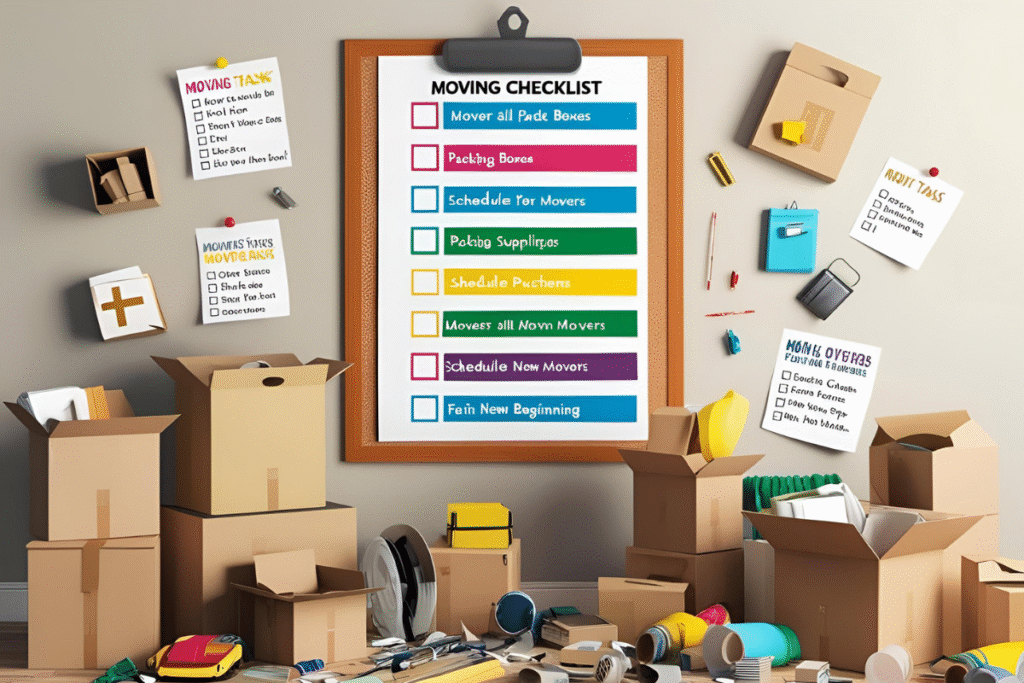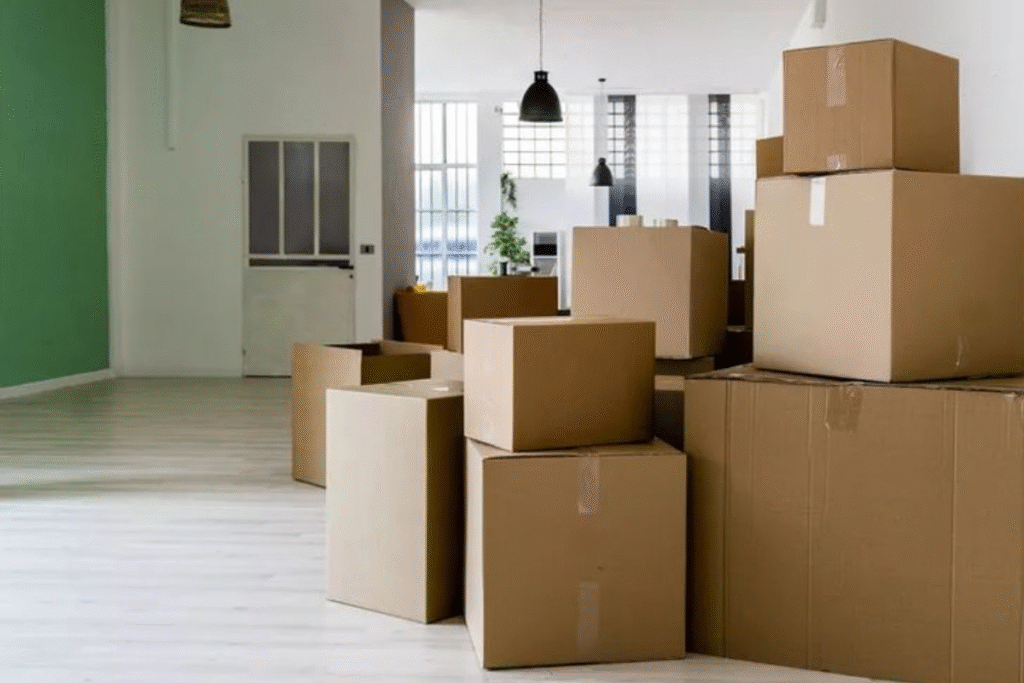Moving into a new home is an exciting milestone, but it also comes with its fair share of challenges. Between packing up your belongings, coordinating logistics, and settling into a new space, it’s easy to feel overwhelmed. Did you know that research shows moving is one of life’s most stressful events, ranking right up there with major life transitions?
Don’t worry – we’ve got you covered! This ultimate moving checklist is designed to simplify the process, break it into manageable stages, and ensure every detail is accounted for. Whether you’re buying your first home, moving into a rental, or relocating with your family, this guide will help you handle it all like a pro.
Get ready to tackle your move with confidence!
Why Use a Moving Checklist?
A moving checklist might seem like just another task on the to-do list, but it’s actually a lifesaver. Here’s why having one is a game-changer for your move:
- Stress Reduction: A moving checklist keeps you focused and reduces the anxiety of forgetting important steps.
- Improved Organization: Structure is key to a successful move. A checklist ensures you know what to do and when to do it.
- Efficiency Boost: By planning ahead, you’ll avoid the last-minute scrambles that waste time and energy.
- Cost Savings: Early decluttering and budgeting within the checklist help you avoid unnecessary expenses.
Moving Stages Breakdown
Moving is best tackled in stages, each with specific tasks to keep you prepared. Here’s how to strategically manage every step, from early planning to settling into your new home.
Stage 1: Planning and Preparation (6–8 Weeks Before the Move)
Moving might feel far away, but this period is crucial for setting a solid foundation.
Key Action Steps:
- Research and Book Movers: Start researching reputable removalists or hire a moving truck if going DIY. Secure your booking early to avoid last-minute disappointments.
- Declutter: Go through your belongings and decide what to keep, donate, sell, or throw away. Decluttering now means fewer items to pack and transport.
- Temporary Storage: If needed, arrange secure storage for items you’re not ready to move.
- Collect Supplies: Gather boxes, tape, markers, bubble wrap, and other packing materials.
- Notify Your Landlord or Agent (if applicable): Provide written notice if you’re ending a rental agreement to avoid complications.
Stage 2: Organizing and Packing (2–4 Weeks Before the Move)
It’s time to start transforming your home’s chaos into an orderly move.
Key Action Steps:
- Pack Non-Essential Items: Start with items you won’t need before the move, like off-season clothes or decor.
- Label Everything: Clearly mark each box with the room it belongs to and its contents. Trust us, your future self will thank you.
- Arrange Utility Transfers: Schedule disconnection at your current home and reconnection at the new one for services like water, electricity, and internet.
- Update Your Address: Notify key contacts and services of your new address, including banks, insurance providers, and subscriptions.
- Organize Insurance: Ensure your home and belongings are protected during the moving process.

Stage 3: Moving Week and Moving Day
The big day is just around the corner, and final preparations are key to avoiding stress.
Key Action Steps:
- Pack Essentials Separately: Designate a “first day” box with essentials like toiletries, a change of clothes, medications, and snacks.
- Defrost the Refrigerator (if applicable): Empty and unplug your fridge 24–48 hours before moving.
- Confirm All Details: Check in with your movers or truck rental company to confirm timing and logistics.
- Protect Your New Home: Use furniture covers, place mats, and protect entryways to avoid damage during unloading.
- Supervise Loading and Unloading: Ensure your belongings are handled carefully and cross-check against your inventory.
Stage 4: Settling In (1–2 Weeks After the Move)
Congratulations – you’ve made it to your new home! Now it’s time to focus on settling in.
Key Action Steps:
- Unpack Strategically: Start with essentials like the kitchen, bathroom, and bedroom to make your first few nights comfortable.
- Double-Check Utilities: Ensure everything from the internet to water is properly connected.
- Explore the Neighborhood: Familiarize yourself with local shops, parks, schools, and amenities.
- Update Your Address Again (if needed): Follow up with any services that may have been missed earlier.
- Check Safety Features: Test smoke detectors, replace locks if necessary, and set up childproofing or pet-proofing measures.
What Makes This Moving Checklist Unique
This isn’t just any checklist – it’s designed to make moving smarter, easier, and stress-free. Here’s how:
- Stage-by-Stage Guidance: We break the process into actionable steps so you always know what’s next.
- Customizable Tool: Tailor this checklist to fit your personal needs, whether it’s a local or long-distance move.
- Decluttering and Budget Tips: We emphasize early decluttering and budgeting to save time, money, and effort.
- Interactive Elements: Use our digital version to track your progress and access additional resources like decluttering guides and packing tips.
Common Moving Challenges (and How to Tackle Them!)
1. Last-Minute Packing
Procrastinating on packing? Don’t panic. Start by setting timers to pack in short, focused bursts—try 25 minutes of packing followed by a 5-minute break. Focus on one room or category of items at a time to stay organized. If you’re really running out of time, enlist help from friends, family, or even hire professional packers to speed up the process. Keep essentials like toiletries, important documents, and a change of clothes in a separate bag for easy access.
2. Utility Hookups
Forgot to connect your utilities before moving in? It happens more often than you think. Many providers, such as electricity, gas, or internet companies, offer expedited connection services for an extra fee. Call them as soon as you realize to set up same-day or next-day installation. In the meantime, consider temporary solutions like mobile hotspots or portable power banks to stay connected.
3. Removalist Disputes
If you run into issues with removalists, such as damaged items, delayed deliveries, or disagreements over pricing, it’s important to stay calm and organized. Keep a detailed, written inventory of your belongings and take photos of items before and after the move as evidence. Any issues should be reported to the removalist company’s customer service immediately, and don’t hesitate to escalate the matter if necessary. If the dispute isn’t resolved, check if they’re part of a governing body or ombudsman for further assistance.
4. Overcoming Emotional Stress
Feeling overwhelmed by the moving process? It’s completely normal to feel stressed during such a big transition. Try breaking down your tasks into smaller, manageable steps to avoid feeling paralyzed by the workload. Prioritize tasks that are most urgent and tackle them one at a time. Don’t be afraid to lean on friends or family for emotional or physical support—they may even offer helpful advice or hands-on assistance. And remember to take breaks to breathe, relax, and recharge; self-care is just as important as the move itself!
Your Smooth Move Starts Here!
Moving doesn’t have to be overwhelming. By following this step-by-step moving checklist, you’ll master the process like a pro. Planning ahead, staying organized, and being mindful of the details ensures a smoother experience from start to finish.
Want an even more personalized moving plan? Download our interactive moving checklist and start checking off tasks today! Plus, we’d love to hear your moving stories or tips in the comments below. Share your experiences and help others make their move stress-free too.
FAQs about moving your home
1. When should I start preparing for my move?
It’s best to start planning your move at least 6–8 weeks in advance. This gives you enough time to organize, sort through your belongings, and address any unforeseen challenges.
2. How do I stay organized during a move?
Using a detailed moving checklist is one of the most effective ways to stay organized. Break tasks into manageable steps, label boxes clearly, and keep all important documents in a dedicated folder.
3. What should I do with items I no longer need?
Consider donating, selling, or recycling items you no longer need. Decluttering before a move helps reduce the number of items to pack and unpack, saving both time and effort.
4. How can I save money on moving expenses?
Start by comparing quotes from different moving companies. Additionally, consider packing on your own where feasible and use free or affordable packing supplies like recycled boxes.
5. What are some tips for moving with children or pets?
Keep routines consistent and involve children in the packing process to make them feel included. For pets, ensure they are comfortably secured on moving day and consider boarding them if the process might be too stressful.
What to Know Before Choosing a Property Developer in the UAE
The UAE’s real estate landscape stands as a testament to architectural excellence and visionary development,…








